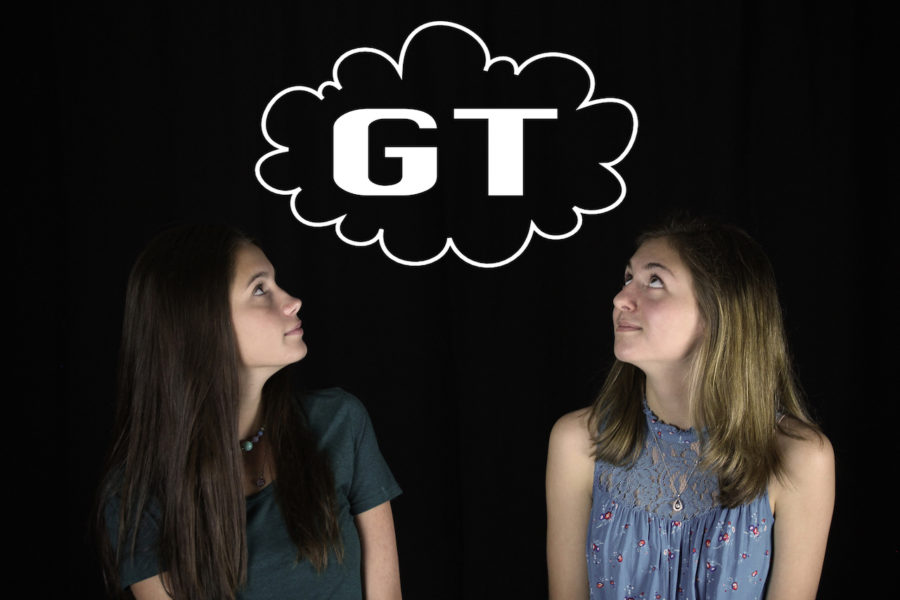In’s and out’s of Gifted and Talented program
October 11, 2016
Senior Hallie Fischer
As I come to my final year of high school, I am starting to look back on things that shaped my education, good and bad. One being the GT program. There are many things I have learned from the Gifted and Talented program in my 12 years of involvement, but now, I would like the GT program to learn a little from me.
To this day, I tell people that I was admitted into the GT program because I knew how many sides were on a triangle when I was 5 years old. More or less, that’s what it was. The only thing I remember was a little picture of a sailboat on the test. I’m sure as a little kindergarten student a long test like that was daunting, but I remember my mom getting the test results back and being super-excited and telling me I did really well. But the only thing that changed for me was that I was pulled from my normal classes and started doing random activities with kids from other classes.
At the time, I never thought I was any different from the other little students, but the Gifted and Talented program knew before I did.
Parents, guardians, teachers, and students, please know that there are many benefits to being in the GT program. Being in a GT class, whether it is in 5th grade or in 11th, allows for a more interactive learning environment. Students are able to test out hypotheses, formulate stories, and craft arguments without the typical textbook teaching style. GT teachers are some of the greatest teachers I’ve ever met, because they understand students on a deep level. I think this really did help prepare me for higher level thinking/classes. Every GT class I’ve had has challenged me to think harder and differently. It made me a more well-rounded thinker and a better learner.
The biggest perk, to me, of the GT program is the teachers. My GT teachers have taught their subject in greater depth, in better detail, and answered my questions better than any other teachers in that field. How? The teachers really understand how their students’ minds crave a deeper understanding. Those teachers know that their students won’t just settle for the answer “because,” and I am so thankful for those teachers, especially Mrs. Greer. I don’t know if you will ever read this, but I want to thank you so much, for everything you did for me. She was with me from Kindergarten until fifth grade; almost everything I learned in elementary school was taught by her. At the start of my first year of school, people thought I was a mute, couple years later; I would go on to become a reporter. When you have a teacher for multiple years, a real bond forms, creating true growth, and I am so thankful for that opportunity.
There is one thing that is really overlooked in the GT program: the social aspect, both positive and negative.
GT kids aren’t just a bunch of socially awkward geniuses that are too scared to be in any other classes. Although I know many GT kids that aren’t the greatest at making friends (myself included), there are also many that love having deep conversations and love the social aspect of school (myself included). A major negative aspect of GT, for me, was that, when I was younger, I really struggled with being social, making friends, and being outgoing. GT didn’t make me an introvert, but often times, it did the opposite to help.
I was in the same classes with the same kids since kindergarten; I learned physics with the kids I learned addition with. Is it a security blanket? For sure, but that isn’t what I needed. I needed to learn how to make new friends every year and have to do group projects with different people. GT isolated me from public school. There are so many lessons that I am learning now, as a senior in high school, about making friends that I probably should have learned years ago.
Another social problem with the GT program is the stigma. There is a negative stigma towards kids in GT. They are considered the nerds and try-hards. If the GT classes didn’t isolate you, then the other students still treated you different. Don’t get me wrong, it has gotten a lot better in high school, but in middle school, there used to be a GT table at lunch.

Districts tend to tell kids that the GT ones are smarter, so they are isolated by their peers. That’s really not true; GT students aren’t that much different than “regular” students. GT should be treated equally, and I am not directing this at the student body. The administration needs to do a better job at integrating students of all learning types closer together.
So the real question that many parents (and maybe students) are wondering is “Is GT worth it?” For the students that qualify, every time I will say yes. But keep in mind, this is only the case for the students that really do need to be in the GT classes. If a student is fit for the program, the positives that you get from being in a simulated, dynamic classroom environment with passionate, unique teachers is an educational dream.
As I apply to college, I feel more equipped to write essays about my educational experience. To name a few benefits that I gained: I am a grade ahead in math credits, I’ve become a stronger writer, and I feel like I have quality skills in group discussion and collaboration. But parents and students, to get the most of your education, involve yourself in other activities, outside that group of GT students. That’s when you will put together your knowledge with your newly developed social skills. Paired together, those two create a student that is no longer just a GT student, but a high school senior who will be attending college this next fall, and in the end, that’s when it all matters.
Freshman Lily Hager
As I stare at the set of numbers on the whiteboard, I yearn to discover their puzzle. As I stare, wondering the system’s secrets, my brain subconsciously clicks. Constantly as I stare at the numbers I discover more. The intensity of my brain causes fire inside my head as I discover so much. These puzzles. I know how to solve them.
School always came easily for me. Grades weren’t something I needed to worry about growing up. Except, for me, there was a better option than going through the motions. I didn’t know it at the time, but teachers began noticing me, and they tracked me down.
I’ve been in GT classes since fourth grade. Before then, even I had my own perceptions about the students who would leave my “regular” class with their tote of notebooks and pencils on their way to advanced math and English. These students were “Gifted and Talented,” but who was I? These GT students were confident and brilliant, but who was I? These students were know-it-alls, goody-two-shoes, and nerds, but who was I? I didn’t know.
I am GT.
Living a GT life without knowing it provided me with expectations I physically could not fill. Walking into math class, I would see a warm-up question on the board. Within seconds, I calculated it in my brain, formed strong opinions about it, and was able to defend my answer. That’s smart.
The next few minutes would be spent wondering what would happen if one number was quadrupled, how to calculate its factors, and what different shapes could be made out of the numbers themselves. That’s GT.
In my non-GT classes, the deeper thoughts and questions were not acknowledged, and my thinking was rarely challenged. My GT thoughts could never be masked, though. My projects often stood out among others, and when asked to explain my unique angle, I didn’t know how to explain. I wasn’t taught how to my express thoughts in a way that helped others to see it too.
As I tried to provoke discussions with classmates about the phenomenons in my mind about lessons, I received looks as to say, “We aren’t supposed to know Lily, and that’s OK,” but I still ached to find out more. I noticed the disconnect between my mind and the minds of my classmates but what caused it was was unknown to me.
Sometimes, I would receive praise for my differences. “That was beautifully written.” “I can tell you put a lot of work into that.” “I never saw it from that perspective.” I learned later that my unique approach to projects is what GT teachers call “thinking outside the box,” a phrase I ended up hearing on a daily basis.
Sometimes, I would be ridiculed. “I don’t understand why you did this.” “Yours doesn’t look like the others.” “This wasn’t what I was looking for,” teachers told me as they deducted points.
This is what it feels like to be GT. “Gifted and Talented,” as teachers call it. I love the way I think; it makes sense to me, but thinking the way I do would be easier if GT students made up more than just 6 to 10 percent of the American student population.
I’ve had the attention of GT teachers since kindergarten. I remember being pulled out of classes to play with other GT students. I didn’t know why I got to leave, but that environment allowed me to thrive at school.
But it wasn’t until third grade when GT teacher Eva Logan stopped me in the hallway to ask me how I felt about math. Soon after, I began to bond with her during GT testing each day. She stretched my brain and read my secret thoughts. Spending time with her allowed me to forget the feelings I didn’t even realize I had before- my itch for challenge.
By fourth grade, I had excelled in the GT tests and agreed to switch to their classes. Being put into classes with people who thought like me changed the culture of my daily life. I was surrounded by people passionately debating about impossible situations. Their passion was contagious to me, and it lit the fire that had been smoking for years.
Discussions got heated at the end of class in fifth grade GT English when Mrs. Garcia would read “Stories With Holes” by Nathan Levy. She would read a complicated riddle, and my classmates and I would sweat with brain power fighting to find the answer while we spewed possible outcomes. I still remember the first riddle. “The man in the mask was afraid to go home because the man with the mask was there.”
In the GT environment, the most active part of my thoughts were thriving. We fed off of each other and had discussions the lesson plan didn’t expect. It allowed each of us to be comfortable and understanding of each other instead of sticking out in a non-GT class.
With these people, I knew that they had the same story. I could tell they thought like me. They had my difference. The same mended disconnection.
Because of the fast pace of GT classes, I finally began learning every day for the first time in my life.
By middle school, any hesitations about being in GT had faded. I appreciated that GT students ask questions such as “why does this work,” and “why does the ‘why’ work?” Each GT class is adjusted to allow discussion and questions to drive the lesson.
Many GT students have agreed that prejudice causes some bonds between GT students and non-GT students difficult to maintain. When I tell someone I’m in GT, I can see a wall building in their eyes between us which is not easily torn down. I hate that I feel that I may have to hide such a large part of my life from people I meet just so that they can get to know me first.
As someone who’s been in both GT and non-GT, I know that the personalities of the two students varies very little. When all somebody knows about me is I’m in GT, they often assume that I’m stuck-up, nerdy, and cocky.
Being in GT classes in no way means that all I want to do is academic-related. Many trademark activities that teachers and experts say GT students are supposed to love are dreaded by some in GT classes. For example, I dread Socratic seminars while most GT students are pumped up and passionate about the topic we will be discussing.
We’re more like the average student than you think. For all the ways GT students may be seen as different from the rest of the school, we’ve got a lot in common as well, especially when it comes to self-worth or personal opinions. We all have different interests, insecurities, or talents.
As we get older, we are more frequently studied. Our brains intrigue scientists, and they’re constantly trying to learn more about what makes us different.I don’t feel that there is a big answer. I wish I could just let one of those researchers live my life for a day. I think they would find the results could be disappointingly boring.
Since I’ve joined GT classes, I’ve learned to embrace my academic differences because they’ve been properly grown. The GT environment helped me develop strong work ethic and confidence that I have today. Through GT classes, I’m learning how to take my thoughts and spread them to others in a way that can help them to see what I see. My thoughts are clearer now.
As I remember who I used to be, I realize I yearned to discover my puzzle. As I walked, wondering my secrets’ meanings, my brain subconsciously clicked. Constantly as I analyzed my identity, I discovered more. The intensity of my brain caused fire inside my head as I discovered so much. This is me. I’ve found who I am.


